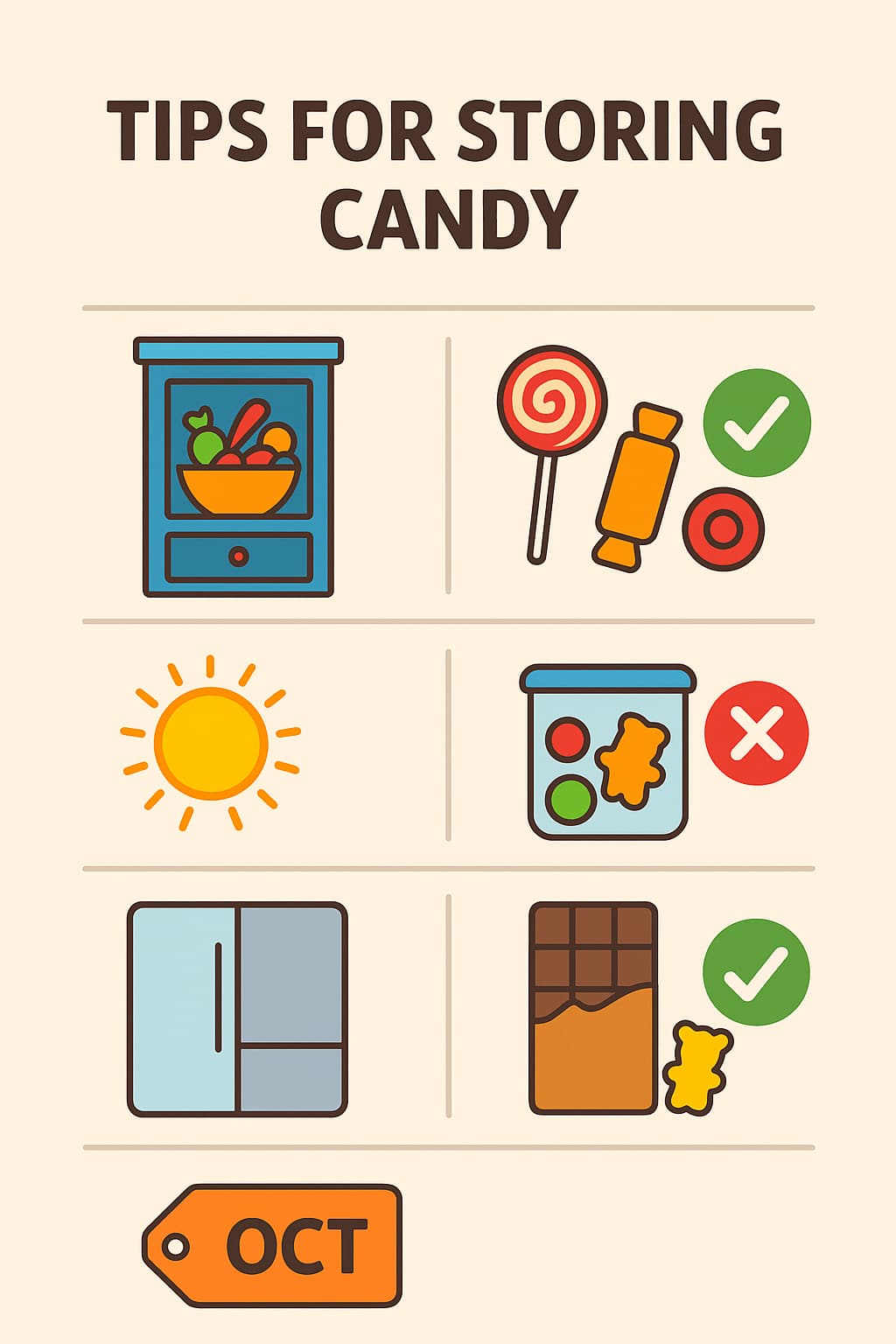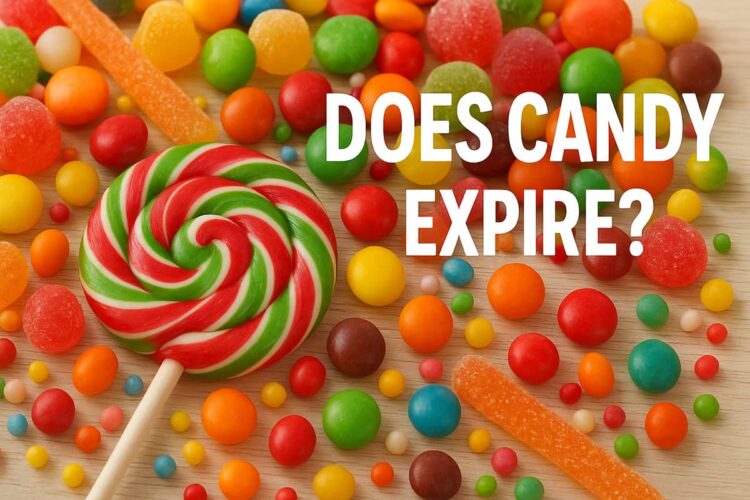One day, while visiting my uncle in Canada, I accidentally opened a drawer on my table while chatting with him and found a lot of candy. I immediately wondered, “Does candy expire?” Who wouldn’t worry when they see candy that looks like it hasn’t been touched in a long time? So, here I’ll explain the shelf life of candy.
This also applies to any candy you find stored for a long time. For example, if you find a random chocolate bar or a bag of gummy bears from months ago, you’ll naturally ask the same question, “Does candy expire?” Well, I’ll answer all of this here based on experience.
The short answer is “yes.” But there’s no need to throw it away so quickly. Unlike milk or bread, which spoil very quickly, candy has a much longer shelf life. This is because candy uses a lot of sugar as a flavoring and natural preservative. However, that doesn’t mean the taste won’t change as it ages.
Here I’ll give you some tips on how to tell if candy expires. When I found a lot of candy in my uncle’s drawer, I tried to open it and taste it, and it still tasted delicious and fresh even though it had been stored there for a long time. Ok, here I will show you about candy expiration, including: how long candy lasts, signs it’s gone bad, smart storage tips, and when it’s better to toss it out.
Does Candy Actually Expire?
Technically, candy can expire, but the spoilage process is different from fresh food. Most candy is made with a low water content and a high sugar content, allowing it to last a long time. Sugar acts as a natural preservative, keeping the candy safe and fresh for a long time. This occurs because the likelihood of bacterial growth is very low; it usually doesn’t become moldy, but it does dry out, lose flavor, and change its texture over time.
Fact: The U.S. Food and Drug Administration notes that foods with low water activity, like hard candy or chocolate, generally last much longer than moist foods.
So, candy can expire, but the most important thing when consuming candy is its quality or freshness, as it doesn’t spoil easily, but it does experience a decline in flavor, texture, or quality.
How Long Does Candy Last?
Different types of candy are made with different ingredients and different measurements, so they have varying shelf lives. Some candies stay fresh for months, even years, if stored properly. Below, I’ve created a table for several types of candy and their respective shelf lives. Hopefully, this will serve as a guide for everyone.
| Candy Type | Average Shelf Life (Unopened) | What Happens Over Time |
|---|---|---|
| Hard Candy (mints, lollipops) | 1 year or more | Can last for years if kept dry |
| Chocolate Bars | 6–12 months | May develop white “bloom” but still safe to eat |
| Gummies & Jellies | 6 months | Become stiff or grainy |
| Taffy & Caramels | 6–12 months | May get sticky or slightly harder |
| Candy Corn | 9 months | Flavor fades with time |
| Licorice | Up to 1 year | Can dry out if not sealed properly |
If you’re still wondering, “How long does candy last after opening?” — the answer is: a lot less. Once exposed to air and moisture, candy quality drops faster.
What Happens When Candy Gets Old?
When candy passes its freshness, it doesn’t suddenly become dangerous, but you will notice some changes:
- Texture: Gummy candies can harden, taffy may get sticky, and chocolate might turn powdery or chalky.
- Color also changes: Chocolate can develop a pale white layer (fat bloom), and gummies might darken.
- Flavor: Old candy can lose its punchy sweetness or even taste a little off.
- Furthermore, over time, the flavor of the candy also changes. But if it smells strange, throw it away.
According to the Eater.com, many candies remain safe after the best-by date if stored properly, but the texture and taste may not be the same.
Candy Storage Tips That Actually Work

Candy can last a very long time if stored properly. Proper storage involves controlling temperature, humidity, and light.
Heed these tips for storing candy properly.
- Cool and dry is best: A pantry or cupboard away from heat sources works great.
- Avoid direct sunlight. Exposed candy can fade colors and sometimes cause it to melt.
- Store in an airtight container to prevent moisture.
- Fridge or freezer? Chocolate can be refrigerated or frozen, but gummies and taffy don’t always handle freezing well.
- Label your stash: If you buy in bulk (hello Halloween!), add dates so you know what’s oldest.
Following these candy storage tips will extend the candy shelf life without sacrificing flavor.
Check Out More:
- Do Popsicles Expire? Popsicle Shelf Life and Storage Tips
- The Ultimate Recipe for Chocolate Oaties
- The Zesty Pickle Shot — A Booze-Free Briny Bite You’ll Crave
When You Should Definitely Throw It Away
Even though candy doesn’t spoil quickly, it can still spoil at some point and you should throw it away. Here are some signs that indicate you should throw it away:
- Mold or fuzzy spots
- A sour or chemical smell
- Slimy, sticky, or leaking texture (especially in gummies or caramel)
- Insects or bugs inside the packaging
- A strong, stale taste
If you’re unsure about these signs of spoilage, just throw it away.
Fun Fact: Candy Crystallization is Real
If you’ve ever bitten into old caramel and found it to have a rough texture, that is sugar crystallization. Sugar molecules rearrange over time, forming small crystals. Hard candies also absorb moisture, causing them to clump together.
This doesn’t immediately make the candy unsafe to eat, but it does affect your experience, and the taste is definitely not as good as when it was fresh.
Is There a Health Risk from Eating Old Candy?
Indeed, expired candy is rarely dangerous, but there are exceptions that you should be aware of. If stored improperly, such as in a warm or humid environment, the candy can attract bacteria or even insects.
Eating candy that already appears spoiled can cause stomach aches, nausea, or other food-related problems. Therefore, in this case, you should trust your senses. If something smells unpleasant or unusual, like sour or rotten, then it is time to throw it away.
Final Thoughts: So, Does Candy Expire?
Yes, candy can expire, but it’s not the same as fresh, perishable foods, especially chocolate and hard candies, which have a very long shelf life. The biggest factors influencing this are how it’s stored and how long it’s been opened.
Old chocolate may develop a white coating, gum may harden, and caramel may become sticky, but this doesn’t necessarily mean the candy is no longer safe. Proper storage means candy can last well beyond the printed date.
So, if you find an old chocolate bar or a piece of gum in your drawer, don’t panic. Just check to see if it’s free of any spoilage. If it looks good and normal, it’s probably safe to eat.












